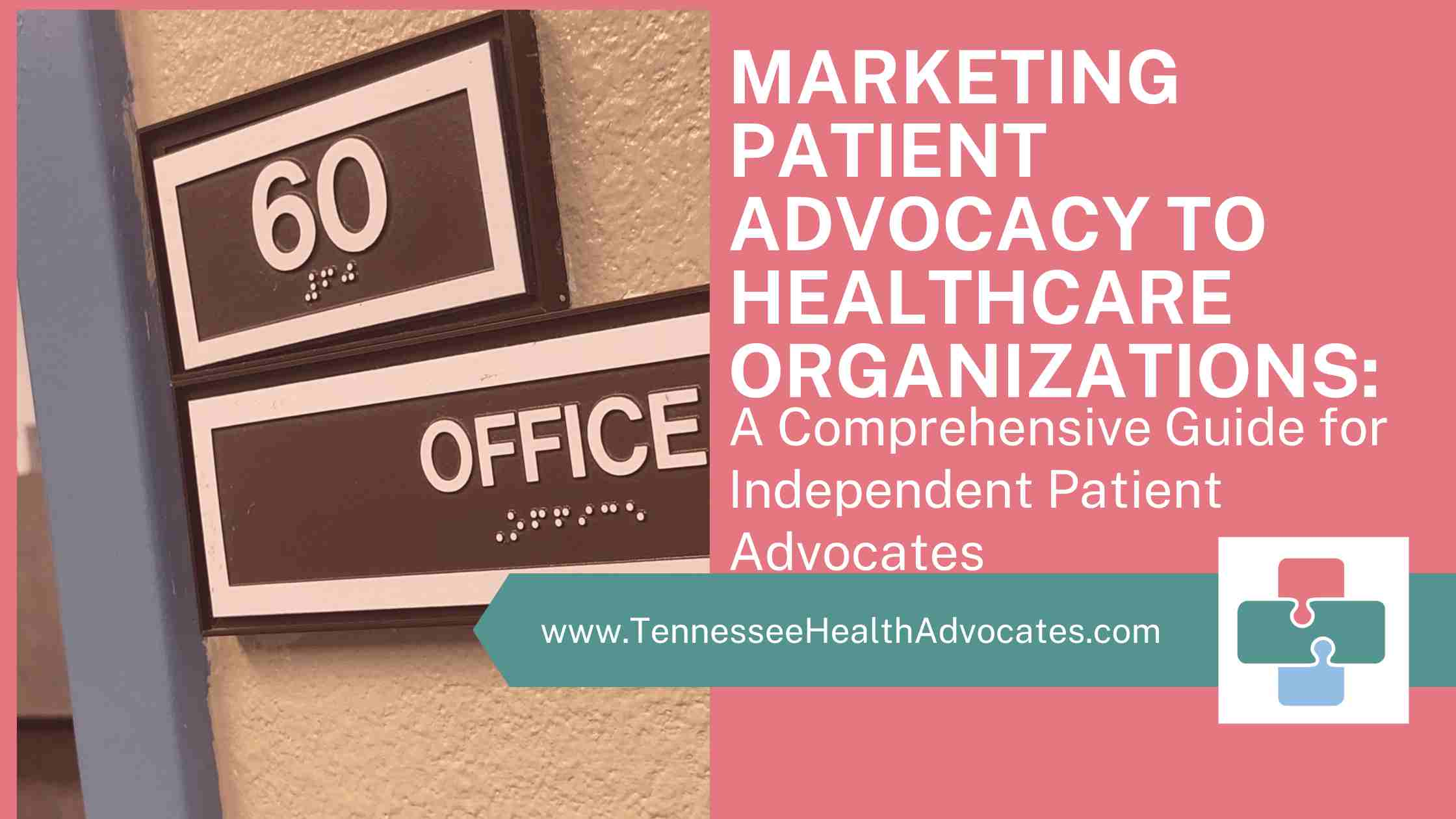Introduction:
Independent Patient Advocates play a pivotal role in ensuring that patients receive the care and support they need. As dedicated professionals we work tirelessly to navigate the complex healthcare system, advocate for patients’ rights, and improve the quality of care. However, as essential as our work is, it’s equally important for us to effectively communicate our services to healthcare organizations. This comprehensive guide aims to shed light on the vital role we play in healthcare, the significance of strategic marketing strategies in promoting our services, and the practicality of cost-effective approaches in achieving these goals. Whether you’re an experienced independent patient advocate or a newcomer to the field, this guide will provide you with valuable insights and actionable steps to successfully market patient advocacy services to healthcare organizations.
Effective Outreach to Healthcare Facilities
The ability to effectively reach out to healthcare facilities is a fundamental aspect of building strong relationships and fostering collaboration. This section delves into three key strategies for making those essential connections as you market patient advocacy to healthcare organizations.
Direct Mail Campaigns
Patient advocates often find success through the age-old but still impactful method of Direct Mail Campaigns. To make this approach work, careful consideration and planning are essential.
- Crafting Targeted Mailings: The cornerstone of an effective direct mail campaign is crafting well-targeted mailings. Rather than adopting a one-size-fits-all approach, it’s vital to do your research and identify the specific healthcare facilities you want to reach. Understanding their unique needs and challenges allows you to tailor your messages to address them directly.
- Including Professional Brochures: Alongside your personalized messages, including professional brochures or information packets about your patient advocacy services can make a significant impact. These materials should convey your expertise, the services you offer, and how you can address the specific pain points of the healthcare facilities you’re targeting.
- Personalizing Messages: Personalization is the key to success in direct mail campaigns. Healthcare administrators and decision-makers are more likely to engage with materials that speak directly to their concerns. Addressing their unique challenges and illustrating how your patient advocacy services can provide solutions is an effective way to capture their attention.
Email Marketing
In today’s digital age, Email Marketing is a powerful tool for patient advocates to connect with healthcare facilities and administrators. It offers the advantage of being both cost-effective and highly targeted.
- Creating Strategic Email Campaigns: Effective email marketing begins with creating strategic campaigns. Craft emails that highlight the value of your patient advocacy services. Tailor your messages to resonate with healthcare decision-makers, showcasing how your services can address their specific needs. Remember, the content should focus on solving their problems.
- Segmenting Email Lists: To ensure you’re reaching the right individuals within healthcare facilities, it’s crucial to segment your email lists. Understanding the roles and responsibilities of the recipients allows you to send content that directly appeals to their interests. A targeted approach is far more effective than a generic one.
- Crafting Compelling Content: The success of an email marketing campaign lies in crafting compelling content. Your subject lines should be attention-grabbing, and the body of the email should be concise yet informative. Focus on how your patient advocacy services can alleviate the challenges faced by healthcare facilities, and present a clear call to action for recipients to follow.
Networking and Conferences
When it comes to building relationships and establishing trust, there’s no substitute for face-to-face interactions. Networking and attending healthcare events and conferences provide a unique opportunity for patient advocates to connect with healthcare professionals and facility administrators.
- Attending Healthcare Events: Healthcare events, such as conferences and trade shows, are fertile ground for making connections. It’s where you can meet healthcare professionals and facility administrators face-to-face. These events offer insights into the latest trends and challenges in the industry, which can inform your approach.
- Face-to-Face Interactions: The value of in-person meetings cannot be overstated. When attending these events, be prepared to succinctly pitch your patient advocacy services. Engage in meaningful conversations, demonstrating your expertise and how you can benefit the healthcare facilities you encounter.
- Pitching Services and Follow-Ups: Your pitch at these events should be clear, concise, and tailored to the specific needs of the healthcare professionals you’re engaging with. Afterward, don’t forget the importance of follow-ups. Nurturing the connections you make at these events can lead to fruitful collaborations in the future. Check out The Inner Circle for more support and guidance on creating your one-liner!
Effective outreach to healthcare facilities involves a combination of traditional and modern methods, each tailored to the unique needs and preferences of the recipients. These strategies provide a comprehensive approach to help you establish meaningful connections with healthcare decision-makers.
Insights on Marketing to Healthcare Organizations
To effectively market patient advocacy services to healthcare organizations, a deep understanding of their unique dynamics and challenges is required. In this section, we’ll explore key insights and strategies to make a lasting impression on healthcare decision-makers and administrators.
Understanding Pain Points
To resonate with healthcare organizations, it’s important to understand their specific pain points. These organizations often grapple with challenges such as improving patient outcomes, reducing costs, and ensuring compliance with ever-evolving regulations. Tailoring your marketing messages to directly address these concerns can make your patient advocacy services more appealing. When healthcare administrators see that you understand their unique struggles, they are more likely to consider your services as valuable solutions.
Highlighting Expertise
Emphasizing your experience and expertise as a patient advocate is a cornerstone of effective healthcare marketing. Share success stories and case studies that vividly illustrate the positive impact you’ve had on patients and healthcare organizations. By showcasing your track record, you build credibility and trust with potential clients. They want to know that they’re working with a professional who can make a real difference in the healthcare landscape.
Leveraging Testimonials and Referrals
Encouraging satisfied clients and professional partners to provide testimonials and referrals can significantly boost your reputation in the healthcare industry. Positive feedback from healthcare professionals and organizations serves as social proof of your efficacy as a patient advocate. These endorsements can instill confidence in potential clients and demonstrate your ability to deliver results.
Staying Informed About Healthcare Trends
The healthcare industry is in a constant state of flux. Staying informed about the latest healthcare trends, regulations, and technologies is essential. This knowledge not only keeps you updated but also positions your services as relevant and aligned with industry developments. It allows you to tailor your patient advocacy approach to meet the changing needs and expectations of healthcare organizations.
Networking
Strategically Building relationships within the healthcare industry is vital for successful marketing. Attend healthcare-related events, join professional associations, and actively connect with key decision-makers. Networking can lead to valuable partnerships and opportunities for collaboration. It’s through these connections that you can truly understand the challenges healthcare organizations face and present your patient advocacy services as viable solutions.
Customized Solutions
In the world of healthcare, there is no one-size-fits-all solution. Every healthcare organization is unique in its structure, goals, and challenges. Tailoring your marketing approach to each organization’s specific needs is crucial. Demonstrating that you can provide customized solutions sets you apart from generic service providers. Whether it’s a large hospital system or a small clinic, showing that you understand their distinct requirements can be the key to securing valuable partnerships.
These insights and strategies offer a comprehensive approach to marketing your patient advocacy services to healthcare organizations. By addressing their pain points, showcasing your expertise, leveraging testimonials and referrals, staying updated on industry trends, networking strategically, and providing customized solutions, you can position yourself as an invaluable partner in the complex healthcare landscape.
Actionable Steps to take Right Now
Now, let’s delve into some actionable steps that can help you effectively market patient advocacy to healthcare organizations and achieve sustainable growth.
Craft a Tailored Marketing Message
Begin by crafting marketing messages that resonate with your target audience. Take the time to understand the specific pain points of the healthcare facilities/organizations you aim to serve. Tailor your message to address these challenges directly. Your marketing content should clearly communicate how your patient advocacy services can provide solutions. Personalization and relevance are key in capturing the attention of decision-makers.
Identify Target Healthcare Facilities
Create a list of specific healthcare facilities and organizations that you want to target. Conduct thorough research to understand their unique needs and challenges. This will allow you to fine-tune your marketing approach and develop content that speaks directly to their concerns. Identifying your targets is a critical step in focusing your efforts effectively.
Develop a Networking Action Plan
Networking is an essential component of marketing your patient advocacy services. Develop a networking action plan that outlines the events, conferences, and professional associations you will engage with. These connections can lead to valuable partnerships and opportunities for collaboration. Be prepared to succinctly present your services and follow up with potential leads. Networking is a dynamic way to foster relationships within the healthcare industry.
Market Research as an Initial Outreach
Utilize your initial outreach to healthcare facilities as an opportunity for market research. Engage in conversations, gather insights, and actively listen to the pain points expressed by healthcare administrators. This data will help you refine your marketing strategy and further tailor your services to meet the needs of your potential clients. Market research serves as the foundation for a successful marketing approach.
Patience and Persistence
One of the most important factors when we market patient advocacy is patience. It’s vital to understand that results may not materialize overnight. Building relationships and gaining the trust of healthcare organizations takes time. Persistence is equally critical. If your initial outreach doesn’t yield the results you desire, don’t be discouraged. Keep trying, refining your approach, and building on the connections you’ve made. The journey to successful marketing is often marked by persistence and tenacity.
By implementing these actionable steps, you can position your services effectively in the healthcare industry. Crafting tailored marketing messages, identifying target healthcare facilities, networking strategically, conducting market research, along with patience and persistence will be key in achieving your goals and making a lasting impact.
Bonus Tip – Review the Market Research Session inside The Circle for more tips and tricks to conducting market research!
Conclusion
In conclusion, the journey to market patient advocacy services to healthcare organizations is both rewarding and challenging. As an independent patient advocate, you possess a unique perspective on the industry. By implementing the strategies and actionable steps outlined in this comprehensive guide, you can navigate this landscape with confidence and make a lasting impact. Remember, understanding healthcare pain points, highlighting your expertise, leveraging testimonials, staying informed about industry trends, and customizing your solutions are all integral to your success.
But the learning never stops, and the healthcare landscape continues to evolve. That’s why I invite you to join The Circle, the ONLY FREE online community connecting independent patient advocates with the tools, resources, and support needed to successfully launch their private practices. Within this vibrant community, you can access live calls, engage in discussions, and tap into a network of like-minded professionals who share your passion for patient advocacy. By being part of The Circle, you’ll have ongoing access to valuable insights, networking opportunities, and the collective knowledge of a supportive community. Together, we can navigate the complexities of the healthcare industry, promote the value of patient advocacy services, and create sustainable and profitable practices that make a meaningful difference. Join The Circle today, and let’s continue this journey together.



[…] you’ve found these tips valuable, check out How to Attract New Clients or How to Market Patient Advocacy. All of my posts are crafted to empower you on your advocacy journey. Explore and absorb the wisdom […]
[…] you’ve found these tips valuable, check out “How to Attract New Clients” or “How to Market Patient Advocacy to Healthcare Organizations”. All of my posts are crafted to empower you on your advocacy journey. Explore and absorb the […]